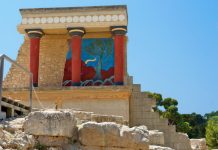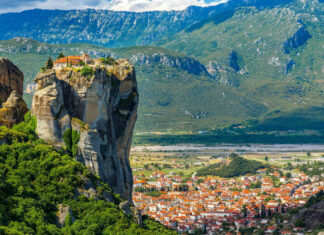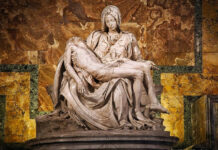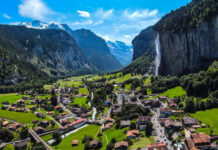Delphi – The Navel of the World
 Nestled on the slopes of Mount Parnassus, Delphi is renowned as the ancient Greeks’ spiritual and religious center. According to myth, Zeus released two eagles from opposite ends of the world, and they met in Delphi, marking it as the “navel” or omphalos of the world. Delphi was home to the Oracle of Apollo, a priestess who channeled the god’s prophecies. The ruins of the Temple of Apollo and the Theater of Delphi transport visitors to an era when seekers from across the ancient world sought guidance and wisdom.
Nestled on the slopes of Mount Parnassus, Delphi is renowned as the ancient Greeks’ spiritual and religious center. According to myth, Zeus released two eagles from opposite ends of the world, and they met in Delphi, marking it as the “navel” or omphalos of the world. Delphi was home to the Oracle of Apollo, a priestess who channeled the god’s prophecies. The ruins of the Temple of Apollo and the Theater of Delphi transport visitors to an era when seekers from across the ancient world sought guidance and wisdom.
Mycenae – The Kingdom of Agamemnon
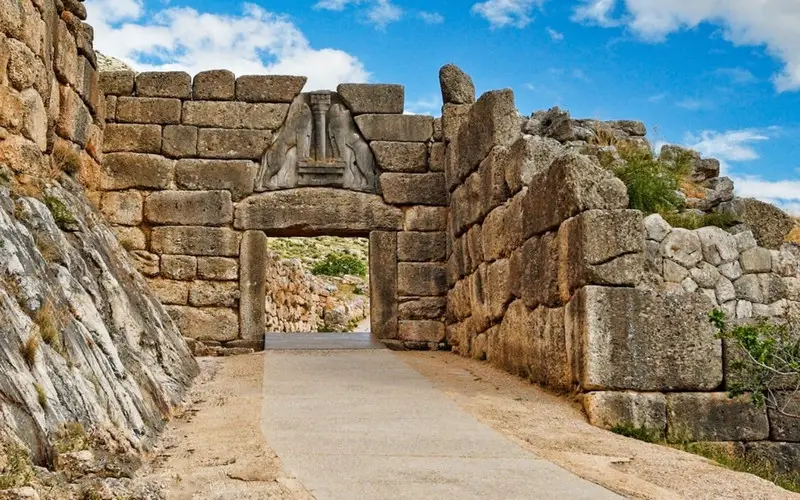 Mycenae, situated in the northeastern Peloponnese, was once a powerful kingdom ruled by the legendary King Agamemnon. According to myth, Agamemnon led the Greeks in the Trojan War, and his homecoming is the central plot of Homer’s epic, the “Odyssey.” The imposing Lion Gate, the Treasury of Atreus (a tholos tomb), and the ruins of the palace evoke the grandeur and drama of the Mycenaean civilization, immortalized in the tales of Homer.
Mycenae, situated in the northeastern Peloponnese, was once a powerful kingdom ruled by the legendary King Agamemnon. According to myth, Agamemnon led the Greeks in the Trojan War, and his homecoming is the central plot of Homer’s epic, the “Odyssey.” The imposing Lion Gate, the Treasury of Atreus (a tholos tomb), and the ruins of the palace evoke the grandeur and drama of the Mycenaean civilization, immortalized in the tales of Homer.
Mount Olympus – Home of the Gods
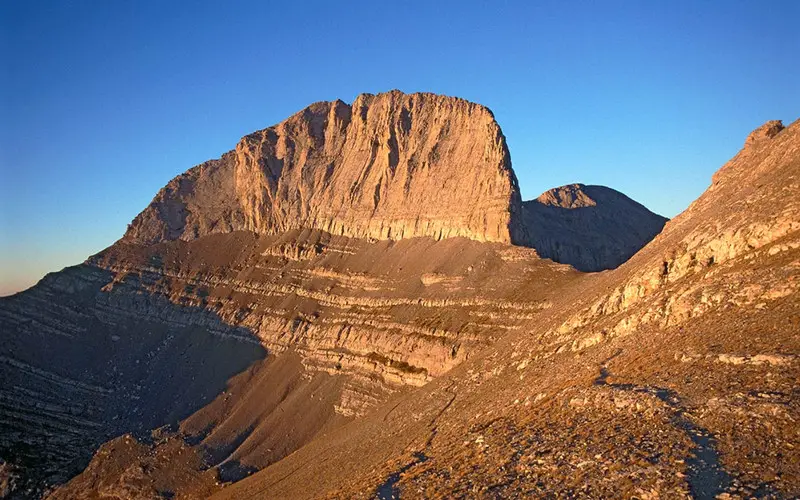 Rising majestically on the border between Thessaly and Macedonia, Mount Olympus is not merely a geographical marvel but also the mythical abode of the Twelve Olympian Gods. According to Greek mythology, Zeus, Hera, Apollo, and the pantheon of gods and goddesses resided on its peaks. A hike through the trails of Mount Olympus offers not only breathtaking views but also a sense of the divine presence that once inspired ancient Greeks.
Rising majestically on the border between Thessaly and Macedonia, Mount Olympus is not merely a geographical marvel but also the mythical abode of the Twelve Olympian Gods. According to Greek mythology, Zeus, Hera, Apollo, and the pantheon of gods and goddesses resided on its peaks. A hike through the trails of Mount Olympus offers not only breathtaking views but also a sense of the divine presence that once inspired ancient Greeks.
Knossos – The Labyrinth of the Minotaur
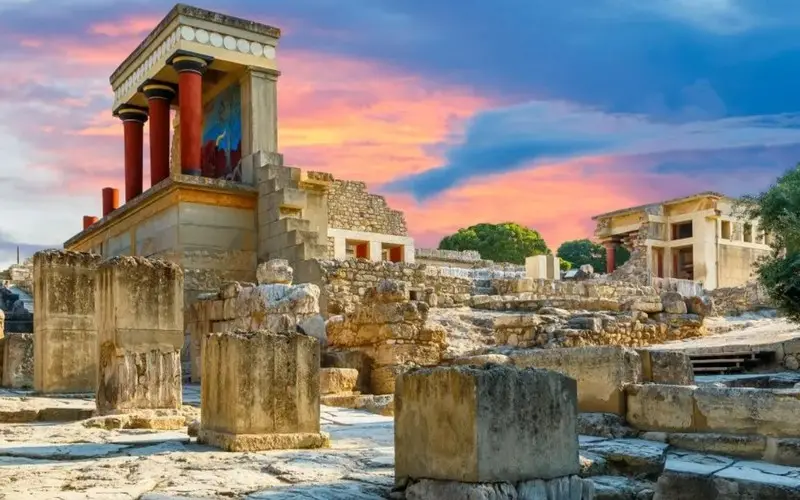 On the island of Crete lies the ancient city of Knossos, a Minoan palace complex associated with the myth of the Minotaur. According to the myth, King Minos commissioned the construction of a labyrinth to contain the Minotaur, a creature with the body of a man and the head of a bull. The legendary King Theseus ventured into the labyrinth to slay the Minotaur and rescue the Athenian tributes. Exploring the ruins of Knossos, visitors can immerse themselves in the labyrinthine history and mythology of this ancient site.
On the island of Crete lies the ancient city of Knossos, a Minoan palace complex associated with the myth of the Minotaur. According to the myth, King Minos commissioned the construction of a labyrinth to contain the Minotaur, a creature with the body of a man and the head of a bull. The legendary King Theseus ventured into the labyrinth to slay the Minotaur and rescue the Athenian tributes. Exploring the ruins of Knossos, visitors can immerse themselves in the labyrinthine history and mythology of this ancient site.
Epidaurus – Sanctuary of Asclepius
 Epidaurus, located on the northeast Peloponnese, was a sanctuary dedicated to Asclepius, the god of healing. According to legend, Asclepius possessed the power to restore health and even resurrect the dead. The sanctuary includes the well-preserved Theatre of Epidaurus, renowned for its acoustics and healing ceremonies. Pilgrims sought solace and divine intervention in the healing rituals conducted here, connecting with the mythological essence of Asclepius.
Epidaurus, located on the northeast Peloponnese, was a sanctuary dedicated to Asclepius, the god of healing. According to legend, Asclepius possessed the power to restore health and even resurrect the dead. The sanctuary includes the well-preserved Theatre of Epidaurus, renowned for its acoustics and healing ceremonies. Pilgrims sought solace and divine intervention in the healing rituals conducted here, connecting with the mythological essence of Asclepius.
Troy – City of the Trojan War
 Troy, immortalized in Homer’s “Iliad,” is an archaeological site in northwestern Turkey, near the Dardanelles. The legendary city witnessed the epic Trojan War, a conflict ignited by the abduction of Helen, Queen of Sparta. The famed wooden horse, a symbol of subterfuge, led to the downfall of Troy. Visiting the archaeological site, travelers can envision the ancient city walls and immerse themselves in the echoes of a mythological war that captivated the ancient world.
Troy, immortalized in Homer’s “Iliad,” is an archaeological site in northwestern Turkey, near the Dardanelles. The legendary city witnessed the epic Trojan War, a conflict ignited by the abduction of Helen, Queen of Sparta. The famed wooden horse, a symbol of subterfuge, led to the downfall of Troy. Visiting the archaeological site, travelers can envision the ancient city walls and immerse themselves in the echoes of a mythological war that captivated the ancient world.
Temple of Poseidon at Cape Sounion – God of the Sea
 Perched dramatically on the cliffs of Cape Sounion, overlooking the Aegean Sea, the Temple of Poseidon pays homage to the god of the sea. According to Greek mythology, Poseidon was one of the Twelve Olympian Gods and the master of the seas. The temple’s strategic location affords breathtaking sunset views, adding a touch of divine splendor to the site. Sailors of ancient times would offer sacrifices to Poseidon here, seeking his favor for safe journeys.
Perched dramatically on the cliffs of Cape Sounion, overlooking the Aegean Sea, the Temple of Poseidon pays homage to the god of the sea. According to Greek mythology, Poseidon was one of the Twelve Olympian Gods and the master of the seas. The temple’s strategic location affords breathtaking sunset views, adding a touch of divine splendor to the site. Sailors of ancient times would offer sacrifices to Poseidon here, seeking his favor for safe journeys.






